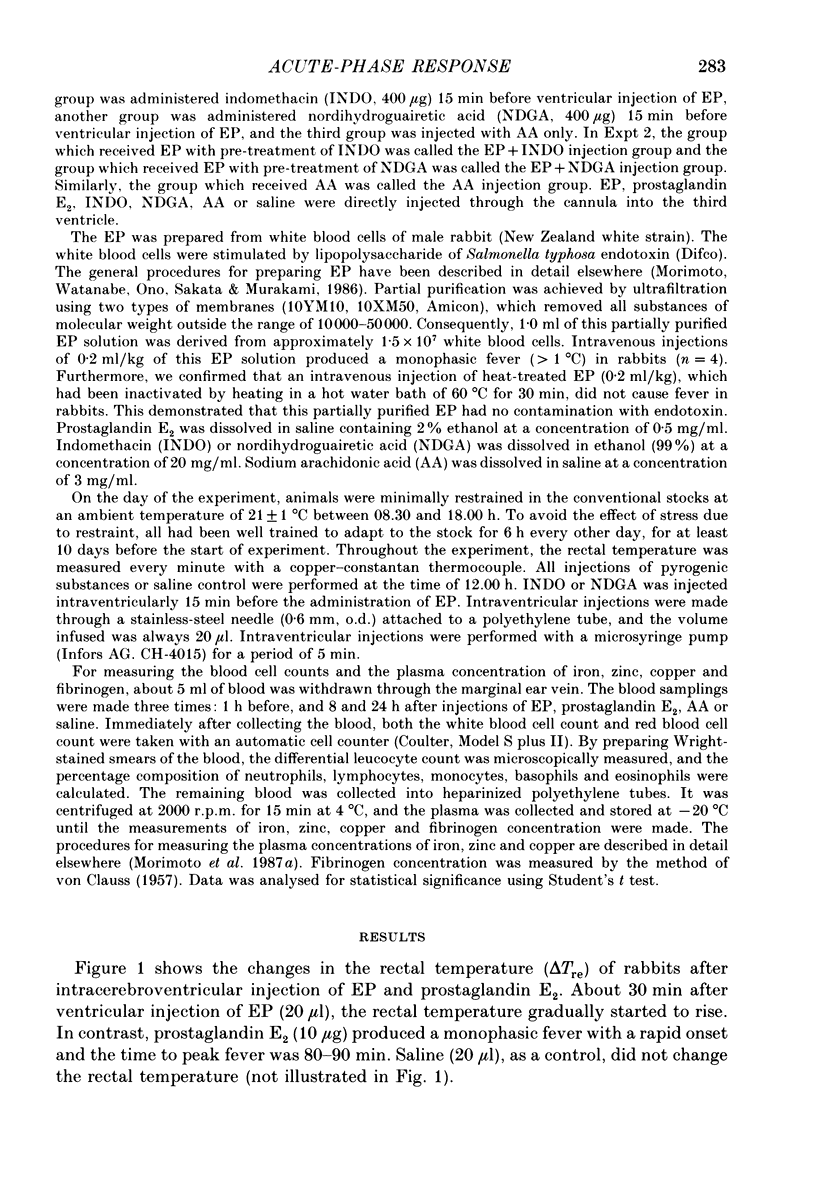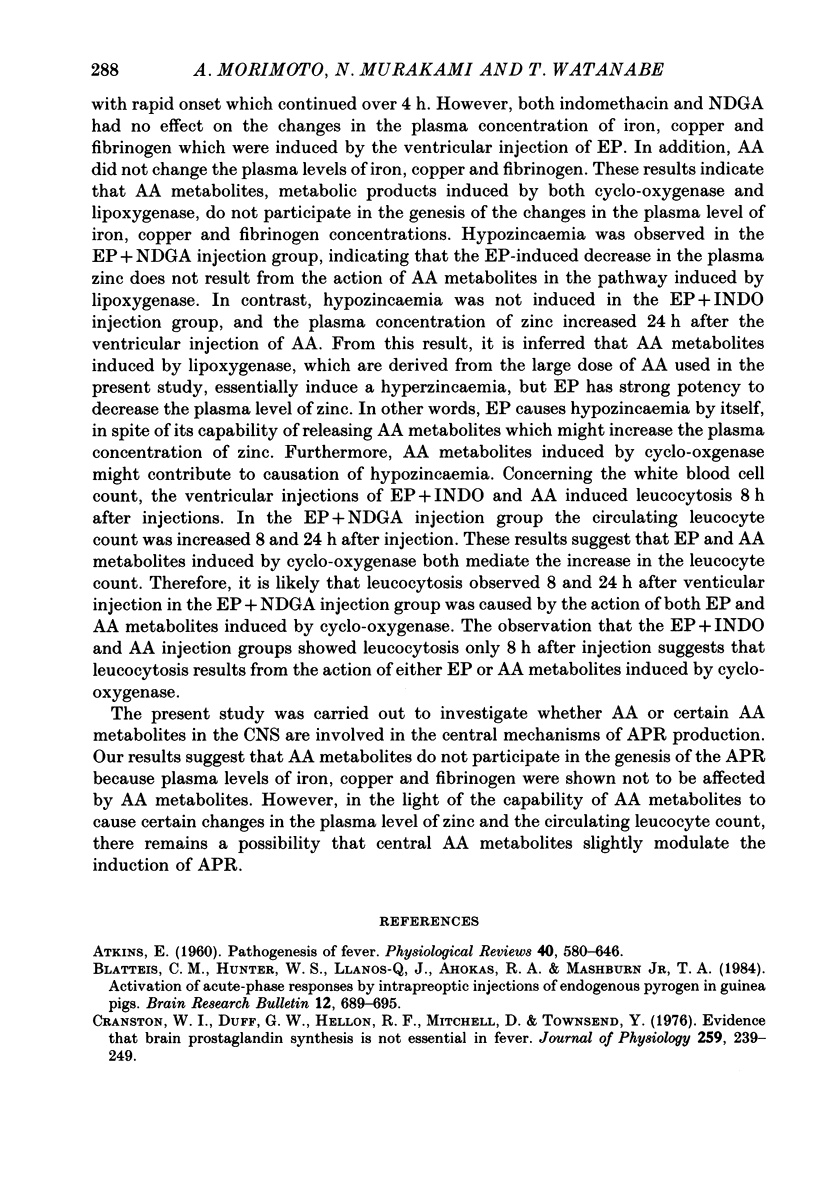Abstract
1. In the present study, endogenous pyrogen (EP), prostaglandin E2 or arachidonic acid was injected into the cerebral ventricle to investigate whether central arachidonic acid metabolites are involved in the development of the acute-phase response. The central effects of a cyclo-oxygenase inhibitor, indomethacin, and of a lipoxygenase inhibitor, nordihydroguairetic acid (NDGA), on the acute-phase response induced by an intracerebroventricular injection of EP were also examined. 2. The ventricular injection of EP decreased the plasma concentrations of iron and zinc, while increasing those of copper and fibrinogen and the circulating leucocyte count. However, ventricular injection of prostaglandin E2 affected neither of them, indicating that prostaglandin E2 does not contribute to the acute-phase response production by itself. 3. Both the ventricular injections of indomethacin and NDGA had no effect on the changes in the plasma concentrations of iron, copper and fibrinogen which were induced by ventricular injection of EP. In addition, when arachidonic acid was administered into the cerebral ventricle, the changes in the plasma levels of iron, copper and fibrinogen were not induced. 4. In contrast, EP-induced hypozincaemia was observed upon pre-treatment with NDGA, but not upon pre-treatment with indomethacin. However, plasma zinc increased after the ventricular injection of arachidonic acid. Ventricular injection of EP alone and of EP with NDGA increased the number of circulating leucocytes 8 and 24 h after the ventricular injection, while ventricular injections of arachidonic acid, and of EP with administration of indomethacin induced leucocytosis 8 h after injections. 5. These results suggest that arachidonic acid metabolites do not participate in the genesis of the acute-phase response.(ABSTRACT TRUNCATED AT 250 WORDS)
Full text
PDF








Selected References
These references are in PubMed. This may not be the complete list of references from this article.
- ATKINS E. Pathogenesis of fever. Physiol Rev. 1960 Jul;40:580–646. doi: 10.1152/physrev.1960.40.3.580. [DOI] [PubMed] [Google Scholar]
- Blatteis C. M., Hunter W. S., Llanos J., Ahokas R. A., Mashburn T. A., Jr Activation of acute-phase responses by intrapreoptic injections of endogenous pyrogen in guinea pigs. Brain Res Bull. 1984 Jun;12(6):689–695. doi: 10.1016/0361-9230(84)90149-7. [DOI] [PubMed] [Google Scholar]
- CLAUSS A. Gerinnungsphysiologische Schnellmethode zur Bestimmung des Fibrinogens. Acta Haematol. 1957 Apr;17(4):237–246. doi: 10.1159/000205234. [DOI] [PubMed] [Google Scholar]
- Cranston W. I., Duff G. W., Hellon R. F., Mitchell D., Townsend Y. Evidence that brain prostaglandin synthesis is not essential in fever. J Physiol. 1976 Jul;259(1):239–249. doi: 10.1113/jphysiol.1976.sp011464. [DOI] [PMC free article] [PubMed] [Google Scholar]
- Cranston W. I., Hellon R. F., Mitchell D., Townsend Y. Intraventricular injections of drugs which inhibit phospholipase A2 suppress fever in rabbits. J Physiol. 1983 Jun;339:97–105. doi: 10.1113/jphysiol.1983.sp014705. [DOI] [PMC free article] [PubMed] [Google Scholar]
- Kluger M. J., Ringler D. H., Anver M. R. Fever and survival. Science. 1975 Apr 11;188(4184):166–168. [PubMed] [Google Scholar]
- Kluger M. J., Rothenburg B. A. Fever and reduced iron: their interaction as a host defense response to bacterial infection. Science. 1979 Jan 26;203(4378):374–376. doi: 10.1126/science.760197. [DOI] [PubMed] [Google Scholar]
- Kluger M. J., Vaughn L. K. Fever and survival in rabbits infected with Pasteurella multocida. J Physiol. 1978 Sep;282:243–251. doi: 10.1113/jphysiol.1978.sp012460. [DOI] [PMC free article] [PubMed] [Google Scholar]
- Kunkel S. L., Chensue S. W., Mouton C., Higashi G. I. Role of lipoxygenase products in murine pulmonary granuloma formation. J Clin Invest. 1984 Aug;74(2):514–524. doi: 10.1172/JCI111449. [DOI] [PMC free article] [PubMed] [Google Scholar]
- Mashburn T. A., Jr, Llanos J., Ahokas R. A., Blatteis C. M. Thermal and acute-phase protein responses of guinea pigs to intrapreoptic injections of leukotrienes. Brain Res. 1986 Jun 25;376(2):285–291. doi: 10.1016/0006-8993(86)90191-5. [DOI] [PubMed] [Google Scholar]
- Merriman C. R., Upchurch H. F., Kampschmidt R. F. Prostaglandin E1, aspirin and the action of leukocytic endogenous mediator. J Pharmacol Exp Ther. 1974 Mar;188(3):516–519. [PubMed] [Google Scholar]
- Milton A. S., Wendlandt S. A possible role for prostaglandin E1 as a modulator for temperature regulation in the central nervous system of the cat. J Physiol. 1970 Apr;207(2):76P–77P. [PubMed] [Google Scholar]
- Morimoto A., Murakami N., Myogin T., Takada M., Teshirogi S., Watanabe T. Separate mechanisms inside and outside the blood-brain barrier inducing metabolic changes in febrile rabbits. J Physiol. 1987 Nov;392:637–649. doi: 10.1113/jphysiol.1987.sp016801. [DOI] [PMC free article] [PubMed] [Google Scholar]
- Morimoto A., Murakami N., Nakamori T., Watanabe T. Evidence for separate mechanisms of induction of biphasic fever inside and outside the blood-brain barrier in rabbits. J Physiol. 1987 Feb;383:629–637. doi: 10.1113/jphysiol.1987.sp016433. [DOI] [PMC free article] [PubMed] [Google Scholar]
- Morimoto A., Watanabe T., Ono T., Sakata Y., Murakami N. Rat endogenous pyrogen and fever. Am J Physiol. 1986 May;250(5 Pt 2):R776–R782. doi: 10.1152/ajpregu.1986.250.5.R776. [DOI] [PubMed] [Google Scholar]
- Sobrado J., Moldawer L. L., Bistrian B. R., Dinarello C. A., Blackburn G. L. Effect of ibuprofen on fever and metabolic changes induced by continuous infusion of leukocytic pyrogen (interleukin 1) or endotoxin. Infect Immun. 1983 Dec;42(3):997–1005. doi: 10.1128/iai.42.3.997-1005.1983. [DOI] [PMC free article] [PubMed] [Google Scholar]
- Stitt J. T., Bernheim H. A. Differences in endogenous pyrogen fevers induced by iv and icv routes in rabbits. J Appl Physiol (1985) 1985 Aug;59(2):342–347. doi: 10.1152/jappl.1985.59.2.342. [DOI] [PubMed] [Google Scholar]
- Tocco R. J., Kahn L. L., Kluger M. J., Vander A. J. Relationship of trace metals to fever during infection: are prostaglandins involved? Am J Physiol. 1983 Mar;244(3):R368–R373. doi: 10.1152/ajpregu.1983.244.3.R368. [DOI] [PubMed] [Google Scholar]


